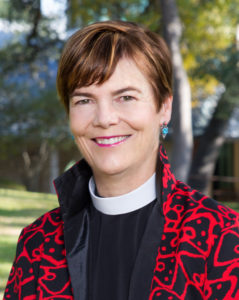The vivid passion story in the gospel of Mark is essential to the meaning of the gospel and is likely the first part of Mark’s story to be told orally and later to be written down. The story of Jesus’ passion is the earth from which the rest of the gospel grew.
It’s a pity that we don’t read this harrowing account throughout the year and bring it into our sermons in winter, summer, and fall. There isn’t time in the Palm Sunday liturgy to hear fully the resonant echoes with other Markan episodes and the underlying melodies of the psalms and prophets. There isn’t enough silence to contemplate Jesus, worker of deeds of power in Galilee, taken over by power: military, temporal, religious, imperial. It takes more than one day or a single week to meditate on the paradoxes that weave through the fabric of this story and that show up as gashes of bright color.
The body of Jesus. An element of the story that bears watching.
The passion narrative opens with the anonymous woman at Bethany, as he reclines at dinner, breaking a jar and pouring oil on Jesus’ head. Some there were angry and scolded her for waste.[1]
“Let her alone; why do you trouble her? She has performed a good service for me. For you always have the poor with you, and you can show kindness to them whenever you wish; but you will not always have me. She has done what she could; she has anointed my body (to soma mou) beforehand for its burial. Truly I tell you, wherever the good news is proclaimed in the whole world, what she has done will be told in remembrance of her.”
She has anointed my body beforehand for its burial. There is something shocking about Jesus speaking reflexively about his own “body.” And then even more frightening, his body’s burial. And then the statement, which might even be read as a command, that this good deed must never be left out of the preaching of the gospel.
The very next meal is the Passover dinner with his disciples and the only other time Jesus speaks of his own body: “Take. This is my body (to soma mou).”[2]
First, a living body anointed for burial. Second, bread called a living body.
After all the noise and clamor and conflict of the arrest, trial, torture, and execution. After darkness obliterates the creation, and Jesus cries out in protest and despair, the passion story concludes, as it began, with attention on the body of Jesus and the action of women.[3]
When evening had come, and since it was the day of Preparation, that is, the day before the sabbath, Joseph of Arimathea, a respected member of the council, who was also himself waiting expectantly for the kingdom of God, went boldly to Pilate and asked for the body of Jesus (to soma tou Iesou). Then Pilate wondered if he were already dead; and summoning the centurion, he asked him whether he had been dead for some time. When he learned from the centurion that he was dead, he granted the body (to ptoma) to Joseph. Then Joseph bought a linen cloth, and taking down the body (taking it down), wrapped it in the linen cloth, and laid it in a tomb that had been hewn out of the rock. He then rolled a stone against the door of the tomb. Mary Magdalene and Mary the mother of Joses saw where the body (it) was laid.
Although the NRSV translation uses “body” four times, the word, soma, body, occurs once in sentence where Joseph “asks for the body of Jesus.”
When Pilate grants the body to Joseph, the word is ptoma, corpse. To the faithful it is body, to the enemy, a corpse.
The word “corpse” would recall to the listeners the eerie tale of John’s murder. John, who baptized and spoke against the king and whom Herod feared was raised in Jesus.[4]
Jesus’ body begins and ends the passion narrative.
At the supper in Bethany, an unexpected anointing of the living.
At the supper in the city, an instruction. Take. This is my body.
Reclaiming Jesus’ body from those who took his life.
And how dead the body is. For Sure.
Sure
Crucified, dead, and buried
Synonymous parallelism, redundancy, or pleonasm
because you are either alive
or not.
On the other hand, when you are so alive that your aliveness
tames the sea and makes bread cover the hills
and makes the world over again, makes the crazy sane
the wounded whole and brings the dying to life,
then your deadness must be made
absolutely certain.
Your final howl.
Testimony by soldier one.
Witness of the women,
especially two mothers and the Magdalene.
Check by Pilate.
Corroboration by soldier two.
Confirmation by Joseph
with his own hands on the flesh
shoulder on the boulder —
the case is watertight —
the women see him
closing the opening
ending the story.[5]
Do you see what I mean? Reading the passion in the gospel of Mark needs more time.
Why is the woman’s anointing Jesus’ body so necessary for preaching the gospel?
In what other place in the gospel of Mark does soma occur? What do you make of that?
How does the motif of Jesus’ body in the passion resonate with you?
How will you take these questions into Easter morning?
[1] Mark 14:1-9
[2] Mark 14:22
[3] Mark 15:42-47
[4] Mark 6:17-29
[5] Kittredge, A Lot of the Way Trees Were Walking: Poems from the Gospel of Mark (Wipf and Stock, 2015) 89.



